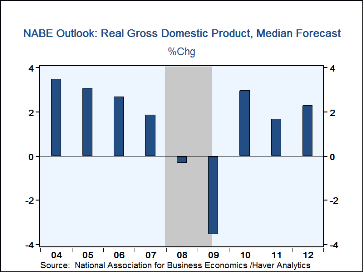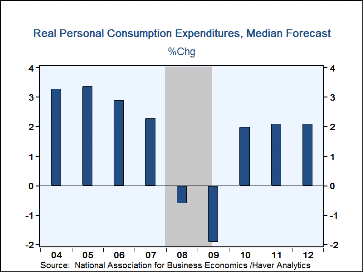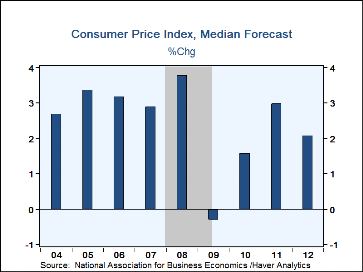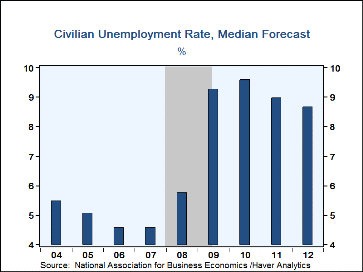 Global| Sep 13 2011
Global| Sep 13 2011NABE Forecast For U.S. Growth Is Reduced Sharply
by:Tom Moeller
|in:Economy in Brief
Summary
The National Association for Business Economics reported another downward revision to the U.S. economic growth forecast. For this year, real GDP growth should average 1.7%, versus 2.8% expected three months ago. For next year, growth [...]
The National Association for Business Economics reported another downward revision to the U.S. economic growth forecast. For this year, real GDP growth should average 1.7%, versus 2.8% expected three months ago. For next year, growth is expected to remain slow at 2.3%, revised down from 3.2% forecasted earlier. Expectations for growth in the economy's various sectors were lowered. Consumer spending now is forecast to rise 2.1% during both this year and next, revised down from 2.8%. Also reduced were expectations for growth in business fixed and residential investment.
Expectations for housing starts were revised lower to 0.70M next year and expected light vehicle sales were reduced to 13.3M. Also lessened were expected gains in payroll employment to a negligible 162,000 per month in 2012, following sharp downward revisions, by the Labor Department, to recent history. The unemployment rate is expected to slip to just 8.7% for all of next year. Higher energy prices forced a slight upward revision to consumer price inflation to 3.0% this year but the 2.1% expectation in 2012 was left unchanged. The bond market is expected to hold onto most of its recent rally with long-term interest rates at 3.37% at year-end 2012 versus a prior expectation of 4.5%. Crude oil prices should average $94 at yearend 2012 versus $90 at yearend 2011.
Improved economic growth is projected to generate positive growth in corporate profitability. However, the 7.3% rise during this year and 6.8% for 2012 were revised lower and remain well below the 19% 2010 increase. Moderate economic growth also is expected to reduce the federal government budget deficit to an unrevised $1.1 trillion in 2012 versus its $1.4 trillion 2009 peak.
The figures from the latest NABE report can be found in Haver's SURVEYS database.
| National Association For Business Economics | 2012 | 2011 | 2010 | 2009 | 2008 |
|---|---|---|---|---|---|
| Real GDP (% Chg. SAAR) | 2.3 | 1.7 | 3.0 | -3.5 | -0.3 |
| Personal Consumption Expenditures | 2.1 | 2.1 | 2.0 | -1.9 | -0.6 |
| Nonresidential Structures | 3.0 | 1.0 | -15.8 | -21.2 | 6.4 |
| Producers' Durable Equipment & Software | 7.7 | 9.2 | 14.6 | -16.0 | -4.3 |
| Residential Investment | 5.8 | -1.6 | -4.3 | -22.2 | -23.9 |
| Change in Real Business Inventories (Bil. $) | 50.0 | 47.0 | 58.8 | -144.9 | -36.3 |
| Real Net Exports (Bil. $) | -387.8 | -403.5 | -421.8 | -358.8 | -494.8 |
| Housing Starts (Mil. Units) | 0.70 | 0.59 | 0.59 | 0.55 | 0.91 |
| Light Vehicle Sales (Mil. Units) | 13.3 | 12.6 | 11.6 | 10.4 | 13.2 |
| Payroll Employment Avg. Monthly Change (000s) | 162 | 124 | 940 | -5,063 | -3,600 |
| Unemployment Rate (%) | 8.7 | 9.0 | 9.6 | 9.3 | 5.8 |
| Consumer Price Index (Y/Y %) | 2.1 | 3.0 | 1.6 | -0.3 | 3.8 |
| Fed Funds Rate (%, Year End) | 0.125 | 0.125 | 0.125 | 0.125 | 0.125 |
| 10-Year Treasury Note (%, Year End) | 3.37 | 2.73 | 3.30 | 3.85 | 2.25 |
Tom Moeller
AuthorMore in Author Profile »Prior to joining Haver Analytics in 2000, Mr. Moeller worked as the Economist at Chancellor Capital Management from 1985 to 1999. There, he developed comprehensive economic forecasts and interpreted economic data for equity and fixed income portfolio managers. Also at Chancellor, Mr. Moeller worked as an equity analyst and was responsible for researching and rating companies in the economically sensitive automobile and housing industries for investment in Chancellor’s equity portfolio. Prior to joining Chancellor, Mr. Moeller was an Economist at Citibank from 1979 to 1984. He also analyzed pricing behavior in the metals industry for the Council on Wage and Price Stability in Washington, D.C. In 1999, Mr. Moeller received the award for most accurate forecast from the Forecasters' Club of New York. From 1990 to 1992 he was President of the New York Association for Business Economists. Mr. Moeller earned an M.B.A. in Finance from Fordham University, where he graduated in 1987. He holds a Bachelor of Arts in Economics from George Washington University.










